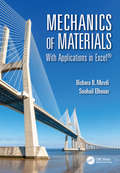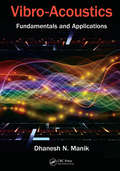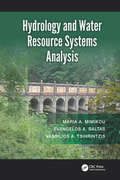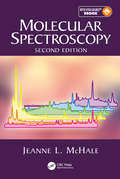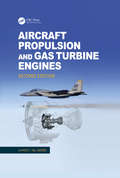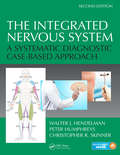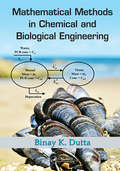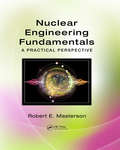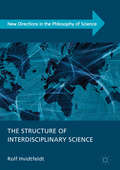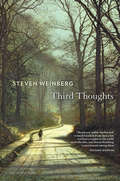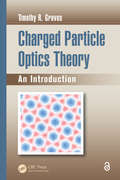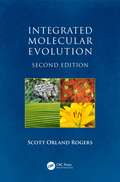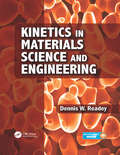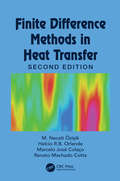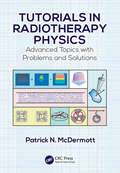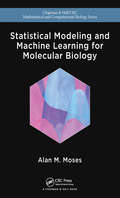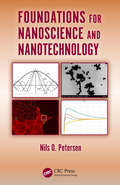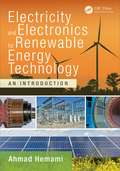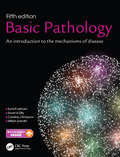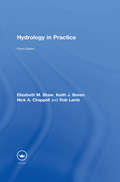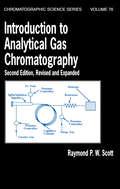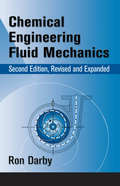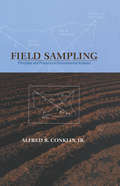- Table View
- List View
Mechanics of Materials: With Applications in Excel
by Bichara B. Muvdi Souhail ElhouarMechanics of Materials: With Applications in Excel® covers the fundamentals of the mechanics of materials—or strength of materials—in a clear and easily understandable way. Each chapter explains the theory of the underlying principles and the applicable mathematical relations, offering examples that illustrate the application of the mathematical relations to physical situations. Then, homework problems—arranged from the simplest to the most demanding—are presented, along with a number of challenging review problems, to ensure comprehension of key concepts. What makes this book unique is that it also instills practical skills for developing Microsoft Excel applications to solve mechanics of materials problems using numerical techniques. Mechanics of Materials: With Applications in Excel® provides editable Excel spreadsheets representing all the examples featured in the text, PowerPoint lecture slides, multimedia simulations, graphics files, and a solutions manual with qualifying course adoption.
Vibro-Acoustics: Fundamentals and Applications
by Dhanesh N. ManikThe subject of vibro-acoustics is important for the design of machine elements and structures, to minimize sound generated by them. For better machine designing, it is necessary for machine designers (mechanical engineers) to have a thorough knowledge of vibro-acoustics. Furthermore, since the design cycles of machines have become shorter, designers will have to design quiet machines at the drawing-board stage rather than applying "band-aid" techniques after the machine has been built. Although there is common ground in the treatment of acoustics, the subject of vibration is not very fortunate. Those interested in low-frequency vibration are generally concerned with the modal approach of using natural frequencies and mode shapes, whereas those interested in vibro-acoustics in medium and high frequencies are generally concerned with the wave approach. Since both modal and wave approaches have their advantages, it is a good idea to study both together to get the best out of them. This is useful for a better understanding the physics of vibro-acoustics. Written for students and professionals interested in gaining knowledge, this book systematically integrates the relevant aspects of vibro-acoustics from various viewpoints.
Hydrology and Water Resource Systems Analysis
by Maria A. Mimikou Evangelos A. Baltas Vassilios A. TsihrintzisHydrology and water resources analysis can be looked at together, but this is the only book which presents the relevant material and which bridges the gap between scientific processes and applications in one text. New methods and programs for solving hydrological problems are outlined in a concise and readily accessible form. Hydrology and Water Resource Systems Analysis includes a number of illustrations and tables, with fully solved example problems integrated within the text. It describes a systematic treatment of various surface water estimation techniques; and provides detailed treatment of theory and applications of groundwater flow for both steady-state and unsteady-state conditions; time series analysis and hydrological simulation; floodplain management; reservoir and stream flow routing; sedimentation and erosion hydraulics; urban hydrology; the hydrological design of basic hydraulic structures; storage spillways and energy dissipation for flood control, optimization techniques for water management projects; and methods for uncertainty analysis. It is written for advanced undergraduate and graduate students and for practitioners. Hydrologists and water-related professionals will be helped with an unfamiliar term or a new subject area, or be given a formula, the procedure for solving a problem, or guidance on the computer packages which are available, or shown how to obtain values from a table of data. For them it is a compendium of hydrological practice rather than science, but sufficient scientific background is provided to enable them to understand the hydrological processes in a given problem, and to appreciate the limitations of the methods presented for solving it.
Molecular Spectroscopy
by Jeanne L. McHaleThis textbook offers an introduction to the foundations of spectroscopic methods and provides a bridge between basic concepts and experimental applications in fields as diverse as materials science, biology, solar energy conversion, and environmental science. The author emphasizes the use of time-dependent theory to link the spectral response in the frequency domain to the behavior of molecules in the time domain, strengthened by two brand new chapters on nonlinear optical spectroscopy and time-resolved spectroscopy. Theoretical underpinnings are presented to the extent necessary for readers to understand how to apply spectroscopic tools to their own interests.
Aircraft Propulsion and Gas Turbine Engines
by Ahmed F. El-SayedAircraft Propulsion and Gas Turbine Engines, Second Edition builds upon the success of the book’s first edition, with the addition of three major topic areas: Piston Engines with integrated propeller coverage; Pump Technologies; and Rocket Propulsion. The rocket propulsion section extends the text’s coverage so that both Aerospace and Aeronautical topics can be studied and compared. Numerous updates have been made to reflect the latest advances in turbine engines, fuels, and combustion. The text is now divided into three parts, the first two devoted to air breathing engines, and the third covering non-air breathing or rocket engines.
The Integrated Nervous System: A Systematic Diagnostic Case-Based Approach, Second Edition
by Walter J. Hendelman Peter Humphreys Christopher R. SkinnerThis innovative textbook is modelled on problem-based learning. It bridges the gap between academic neuroanatomy and clinical neurology and effectively takes the reader from the classroom to the clinic, so that learning can be applied in practice. This second edition has been updated and expanded to include many more clinical cases within both the book and the accompanying Wweb site. Significant additions include abbreviated presentation of the history and neurologic examination of all the cases on the web site (now numbering over 50) within the text at the end of each of the clinical chapters. new ‘maps’ -- visual representations of the clinical motor, sensory and reflex findings. the web site further expands the cases – presenting them in detail, and providing an ‘expert’ commentary to discuss the reasoning for the localization and etiological diagnosis. This book and the associated Web site will be of practical value to all the professionals who deal with people who have neurological conditions, as well as being invaluable to medical students and residents. This includes physiatrists (rehabilitation medicine specialists), physiotherapists, occupational therapists and speech therapists, and nurses who specialize in the care of neurological patients. We think that this text will also be of value for family physicians and specialists in internal medicine and pediatrics, all of whom must differentiate between organic pathology of the nervous system and other conditions.
Mathematical Methods in Chemical and Biological Engineering
by Binay Kanti DuttaMathematical Methods in Chemical and Biological Engineering describes basic to moderately advanced mathematical techniques useful for shaping the model-based analysis of chemical and biological engineering systems. Covering an ideal balance of basic mathematical principles and applications to physico-chemical problems, this book presents examples drawn from recent scientific and technical literature on chemical engineering, biological and biomedical engineering, food processing, and a variety of diffusional problems to demonstrate the real-world value of the mathematical methods. Emphasis is placed on the background and physical understanding of the problems to prepare students for future challenging and innovative applications.
Nuclear Engineering Fundamentals: A Practical Perspective
by Robert E. MastersonNUCLEAR ENGINEERING FUNDAMENTALS is the most modern, up-to-date, and reader friendly nuclear engineering textbook on the market today. It provides a thoroughly modern alternative to classical nuclear engineering textbooks that have not been updated over the last 20 years. Printed in full color, it conveys a sense of awe and wonder to anyone interested in the field of nuclear energy. It discusses nuclear reactor design, nuclear fuel cycles, reactor thermal-hydraulics, reactor operation, reactor safety, radiation detection and protection, and the interaction of radiation with matter. It presents an in-depth introduction to the science of nuclear power, nuclear energy production, the nuclear chain reaction, nuclear cross sections, radioactivity, and radiation transport. All major types of reactors are introduced and discussed, and the role of internet tools in their analysis and design is explored. Reactor safety and reactor containment systems are explored as well. To convey the evolution of nuclear science and engineering, historical figures and their contributions to evolution of the nuclear power industry are explored. Numerous examples are provided throughout the text, and are brought to life through life-like portraits, photographs, and colorful illustrations. The text follows a well-structured pedagogical approach, and provides a wide range of student learning features not available in other textbooks including useful equations, numerous worked examples, and lists of key web resources. As a bonus, a complete Solutions Manual and .PDF slides of all figures are available to qualified instructors who adopt the text. More than any other fundamentals book in a generation, it is student-friendly, and truly impressive in its design and its scope. It can be used for a one semester, a two semester, or a three semester course in the fundamentals of nuclear power. It can also serve as a great reference book for practicing nuclear scientists and engineers. To date, it has achieved the highest overall satisfaction of any mainstream nuclear engineering textbook available on the market today.
The Structure of Interdisciplinary Science (New Directions in the Philosophy of Science)
by Rolf HvidtfeldtThis book presents a novel approach to the analysis of interdisciplinary science based on the contemporary philosophical literature on scientific representation. The basic motivation for developing this approach is that epistemic issues are insufficiently dealt with in the existing literature on interdisciplinarity. This means that when interdisciplinary science is praised (as it often is), it is far from clear to what extent this praise is merited – at least if one cares about various more or less standardised measures of scientific quality. To develop a more adequate way of capturing what is going on in interdisciplinary science, the author draws inspiration from the rich philosophical literature on modelling, idealisation, perspectivism, and scientific pluralism. The discussion hereof reveals a number of critical pitfalls related to transferring mathematical and conceptual tools between scientific contexts, which should be relevant and interesting for anyone actively engaged in funding, evaluating, or carrying out interdisciplinary science.
The Structure of Interdisciplinary Science (New Directions in the Philosophy of Science)
by Rolf HvidtfeldtThis book presents a novel approach to the analysis of interdisciplinary science based on the contemporary philosophical literature on scientific representation. The basic motivation for developing this approach is that epistemic issues are insufficiently dealt with in the existing literature on interdisciplinarity. This means that when interdisciplinary science is praised (as it often is), it is far from clear to what extent this praise is merited – at least if one cares about various more or less standardised measures of scientific quality. To develop a more adequate way of capturing what is going on in interdisciplinary science, the author draws inspiration from the rich philosophical literature on modelling, idealisation, perspectivism, and scientific pluralism. The discussion hereof reveals a number of critical pitfalls related to transferring mathematical and conceptual tools between scientific contexts, which should be relevant and interesting for anyone actively engaged in funding, evaluating, or carrying out interdisciplinary science.
Third Thoughts
by Steven WeinbergOne of the world’s most captivating scientists challenges us to think about nature’s foundations and the entanglement of science and society. Steven Weinberg, author of The First Three Minutes, offers his views on fascinating aspects of physics and the universe, but does not seclude science behind disciplinary walls, or shy away from politics.
Third Thoughts
by Steven WeinbergOne of the world’s most captivating scientists challenges us to think about nature’s foundations and the entanglement of science and society. Steven Weinberg, author of The First Three Minutes, offers his views on fascinating aspects of physics and the universe, but does not seclude science behind disciplinary walls, or shy away from politics.
Charged Particle Optics Theory: An Introduction (Optical Sciences and Applications of Light)
by Timothy R. GrovesCharged Particle Optics Theory: An Introduction identifies the most important concepts of charged particle optics theory, and derives each mathematically from the first principles of physics. Assuming an advanced undergraduate-level understanding of calculus, this book follows a logical progression, with each concept building upon the preceding one. Beginning with a non-mathematical survey of the optical nature of a charged particle beam, the text:Discusses both geometrical and wave optics, as well as the correspondence between themDescribes the two-body scattering problem, which is essential to the interaction of a fast charged particle with matterIntroduces electron emission as a practical consequence of quantum mechanicsAddresses the Fourier transform and the linear second-order differential equationIncludes problems to amplify and fill in the theoretical details, with solutions presented separatelyCharged Particle Optics Theory: An Introduction makes an ideal textbook as well as a convenient reference on the theoretical origins of the optics of charged particle beams. It is intended to prepare the reader to understand the large body of published research in this mature field, with the end result translated immediately to practical application.
Integrated Molecular Evolution
by Scott Orland RogersEvolutionary biology has increasingly relied upon tools developed in molecular biology that allow for the structure and function of macromolecules to be used as data for exploring the patterns and processes of evolutionary change. Integrated Molecular Evolution, Second Edition is a textbook intended to expansively and comprehensive review evolutionary studies now routinely using molecular data. This new edition has been thoroughly updated and expanded, and provides a basic summary of evolutionary biology as well as a review of current phylogenetics and phylogenomics. Reflecting a burgeoning pedagogical landscape, this new edition includes nearly double the number of chapters, including a new section on molecular and bioinformatic methods. Dedicated chapters were added on: Evolution of the genetic code Mendelian genetics and population genetics Natural selection Horizontal gene transfers Animal development and plant development Cancer Extraction of biological molecules Analytical methods Sequencing methods and sequencing analyses Omics Phylogenetics and phylogenetic networks Protein trafficking Human genomics More than 400 illustrations appear in this edition, doubling the number included in the first edition, and over 100 of these diagrams are now in color. The second edition combines and integrates extensive summaries of genetics and evolutionary biology in a manner that is accessible for students at either the graduate or undergraduate level. It also provides both the basic foundations of molecular evolution, such as the structure and function of DNA, RNA and proteins, as well as more advanced chapters reviewing analytical techniques for obtaining sequences, and interpreting and archiving molecular and genomic data.
Kinetics in Materials Science and Engineering
by Dennis W. Readey"A pedagogical gem…. Professor Readey replaces ‘black-box’ explanations with detailed, insightful derivations. A wealth of practical application examples and exercise problems complement the exhaustive coverage of kinetics for all material classes." –Prof. Rainer Hebert, University of Connecticut "Prof. Readey gives a grand tour of the kinetics of materials suitable for experimentalists and modellers…. In an easy-to-read and entertaining style, this book leads the reader to fundamental, model-based understanding of kinetic processes critical to development, fabrication and application of commercially-important soft (polymers, biomaterials), hard (ceramics, metals) and composite materials. It is a must-have for anyone who really wants to understand how to make materials and how they will behave in service." --Prof. Bill Lee, Imperial College London, Fellow of the Royal Academy of Engineering "A much needed text filing the gap between an introductory course in materials science and advanced materials-specific kinetics courses. Ideal for the undergraduate interested in an in-depth study of kinetics in materials." –Prof. Mark E. Eberhart, Colorado School of Mines This book provides an in-depth introduction to the most important kinetic concepts in materials science, engineering, and processing. All types of materials are addressed, including metals, ceramics, polymers, electronic materials, biomaterials, and composites. The expert author with decades of teaching and practical experience gives a lively and accessible overview, explaining the principles that determine how long it takes to change material properties and make new and better materials. The chapters cover a broad range of topics extending from the heat treatment of steels, the processing of silicon integrated microchips, and the production of cement, to the movement of drugs through the human body. The author explicitly avoids "black box" equations, providing derivations with clear explanations.
Finite Difference Methods in Heat Transfer (Heat Transfer)
by M. Necati Özişik Helcio R. Orlande Marcelo J. Colaço Renato M. CottaFinite Difference Methods in Heat Transfer, Second Edition focuses on finite difference methods and their application to the solution of heat transfer problems. Such methods are based on the discretization of governing equations, initial and boundary conditions, which then replace a continuous partial differential problem by a system of algebraic equations. Finite difference methods are a versatile tool for scientists and for engineers. This updated book serves university students taking graduate-level coursework in heat transfer, as well as being an important reference for researchers and engineering. Features Provides a self-contained approach in finite difference methods for students and professionals Covers the use of finite difference methods in convective, conductive, and radiative heat transfer Presents numerical solution techniques to elliptic, parabolic, and hyperbolic problems Includes hybrid analytical–numerical approaches
Tutorials in Radiotherapy Physics: Advanced Topics with Problems and Solutions
by Patrick N. McDermottThe Topics Every Medical Physicist Should Know Tutorials in Radiotherapy Physics: Advanced Topics with Problems and Solutions covers selected advanced topics that are not thoroughly discussed in any of the standard medical physics texts. The book brings together material from a large variety of sources, avoiding the need for you to search through and digest the vast research literature. The topics are mathematically developed from first principles using consistent notation. Clear Derivations and In-Depth Explanations The book offers insight into the physics of electron acceleration in linear accelerators and presents an introduction to the study of proton therapy. It then describes the predominant method of clinical photon dose computation: convolution and superposition dose calculation algorithms. It also discusses the Boltzmann transport equation, a potentially fast and accurate method of dose calculation that is an alternative to the Monte Carlo method. This discussion considers Fermi–Eyges theory, which is widely used for electron dose calculations. The book concludes with a step-by-step mathematical development of tumor control and normal tissue complication probability models. Each chapter includes problems with solutions given in the back of the book. Prepares You to Explore Cutting-Edge Research This guide provides you with the foundation to read review articles on the topics. It can be used for self-study, in graduate medical physics and physics residency programs, or in vendor training for linacs and treatment planning systems.
Statistical Modeling and Machine Learning for Molecular Biology (Chapman & Hall/CRC Mathematical and Computational Biology (Third Edition))
by Alan MosesMolecular biologists are performing increasingly large and complicated experiments, but often have little background in data analysis. The book is devoted to teaching the statistical and computational techniques molecular biologists need to analyze their data. It explains the big-picture concepts in data analysis using a wide variety of real-world molecular biological examples such as eQTLs, ortholog identification, motif finding, inference of population structure, protein fold prediction and many more. The book takes a pragmatic approach, focusing on techniques that are based on elegant mathematics yet are the simplest to explain to scientists with little background in computers and statistics.
Foundations for Nanoscience and Nanotechnology
by Nils O. PetersenDo you ever wonder why size is so important at the scale of nanosystems? Do you want to understand the fundamental principles that govern the properties of nanomaterials? Do you want to establish a foundation for working in the field of nanoscience and nanotechnology? Then this book is written with you in mind. Foundations for Nanoscience and Nanotechnology provides some of the physical chemistry needed to understand why properties of small systems differ both from their constituent molecular entities and from the corresponding bulk matter. This is not a book about nanoscience and nanotechnology, but rather an exposition of basic knowledge required to understand these fields. The collection of topics makes it unique, and these topics include: The concept of quantum confinement and its consequences for electronic behaviour (Part II) The importance of surface thermodynamics for activity and interactions of nanoscale systems (Part III) The need to consider fluctuations as well as mean properties in small systems (Part IV) The interaction of light with matter and specific applications of spectroscopy and microscopy (Part V) This book is written for senior undergraduates or junior graduate students in science or engineering disciplines who wish to learn about or work in the areas of nanoscience and nanotechnology, but who do not have the requisite background in chemistry or physics. It may also be useful as a refresher or summary text for chemistry and physics students since the material is focused on those aspects of quantum mechanics, thermodynamics, and statistical mechanics that specifically relate to the size of objects.
Electricity and Electronics for Renewable Energy Technology: An Introduction (Power Electronics and Applications Series)
by Ahmad HemamiElectricity and Electronics for Renewable Energy Technology: An Introduction provides a foundational understanding of electricity and the methods and devices specific to electricity from renewable sources. The book begins with a brief explanation of the necessary mathematics and then: Addresses the basics of electricity and relationships, motors and generators, transformers, and networks and distribution Tackles the key concepts associated with electronics, diodes and transistors, switching devices, and power converters Covers digital electronics from number systems and logic circuits to encoders and decoders Explores advanced subjects such as reactive power and the operation of a transistor A lab manual and PowerPoint presentation are available with qualifying course adoption. Featuring extensive review questions and practice problems at the end of each chapter, Electricity and Electronics for Renewable Energy Technology: An Introduction instills an essential knowledge of electricity and electronics required for work with renewable energy.
Basic Pathology: An introduction to the mechanisms of disease
by Sunil R. Lakhani Caroline J. Finlayson Susan A. Dilly Mitesh GandhiAn accessible and enjoyable introduction to pathology and the mechanisms of disease, this book puts pathology into its historical, scientific and clinical context. Organized in four main themes - What is a Disease, Defense Against Disease, Circulatory Disorders and Disorders of Cell Growth - the text highlights key mechanisms and their interplay in producing symptoms, signs and disease. Supplemented throughout with colorful cartoons, and much-praised clinical scenarios, this entertaining look at pathology offers historical anecdotes and helpful key-points boxes.
Hydrology in Practice
by Elizabeth M. Shaw Keith J. Beven Nick A. Chappell Rob LambHydrology in Practice is an excellent and very successful introductory text for engineering hydrology students who go on to be practitioners in consultancies, the Environment Agency, and elsewhere. This fourth edition of Hydrology in Practice, while retaining all that is excellent about its predecessor, by Elizabeth M. Shaw, replaces the material on the Flood Studies Report with an equivalent section on the methods of the Flood Estimation Handbook and its revisions. Other completely revised sections on instrumentation and modelling reflect the many changes that have occurred over recent years. The updated text has taken advantage of the extensive practical experience of the staff of JBA Consulting who use the methods described on a day-to-day basis. Topical case studies further enhance the text and the way in which students at undergraduate and MSc level can relate to it. The fourth edition will also have a wider appeal outside the UK by including new material on hydrological processes, which also relate to courses in geography and environmental science departments. In this respect the book draws on the expertise of Keith J. Beven and Nick A. Chappell, who have extensive experience of field hydrological studies in a variety of different environments, and have taught undergraduate hydrology courses for many years. Second- and final-year undergraduate (and MSc) students of hydrology in engineering, environmental science, and geography departments across the globe, as well as professionals in environmental protection agencies and consultancies, will find this book invaluable. It is likely to be the course text for every undergraduate/MSc hydrology course in the UK and in many cases overseas too.
Introduction to Analytical Gas Chromatography, Revised and Expanded (Chromatographic Science Series)
by Raymond P.W. ScottCovering the principles of chromatographic separation, the chromatographic process from a physical chemical perspective, instrumentation for performing analyses, and operational procedures, this second edition offers information needed for the successful practice of gas chromatography. It contains examples of available apparatus, detectors, columns, stationary phases and operating conditions.
Chemical Engineering Fluid Mechanics, Revised and Expanded
by Ronald Darby Ron Darby Raj P. ChhabraCombining comprehensive theoretical and empirical perspectives into a clearly organized text, Chemical Engineering Fluid Mechanics, Second Edition discusses the principal behavioral concepts of fluids and the basic methods of analysis for resolving a variety of engineering situations. Drawing on the author's 35 years of experience, the book covers real-world engineering problems and concerns of performance, equipment operation, sizing, and selection from the viewpoint of a process engineer. It supplies over 1500 end-of-chapter problems, examples, equations, literature references, illustrations, and tables to reinforce essential concepts.
Field Sampling: Principles and Practices in Environmental Analysis (Books in Soils, Plants, and the Environment)
by Alfred R. Conklin Jr.Written by a renowned professional with more than 30 years of experience in environmental sampling and analysis, this reference describes in unparalleled detail all the essential elements for the development and execution of a successful sampling plan at both contaminated and uncontaminated sites. The book covers presampling planning and decision-making, specific sampling situations, and correct sample labeling, and presents the framework and background for the sampling of any contaminated site. Presenting a wide variety of models, quality control procedures, and valuable troubleshooting methods, Field Sampling contains an abundance of topics never before covered in any other source.
